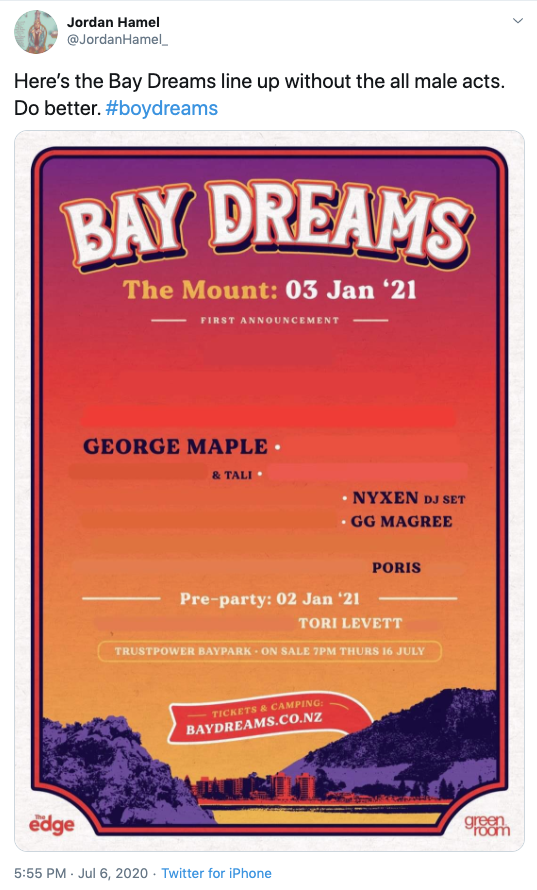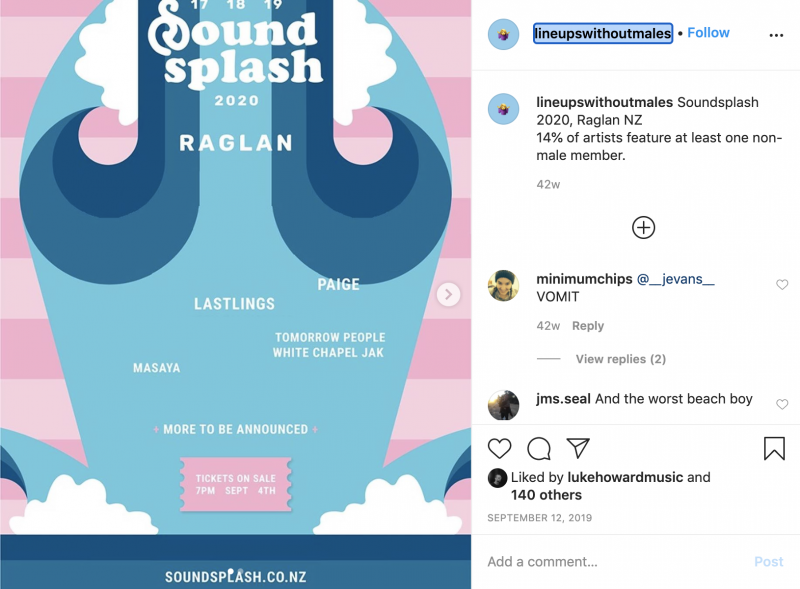By Maggie Shui
The latest Bay Dreams lineup has reignited conversations about the lack of gender diversity on New Zealand’s music festival stages. We look at why the usual defences of either lack of supply or lack of demand for non-male acts doesn’t cut it anymore.
A cornerstone of summer music festivals is the ‘aftermovie’. Released by organisers in the weeks following a festival, the video recap gives attendees a chance to relive the euphoria of the event and actually get a good view of the stage. For those who didn’t go that year, the video serves as a trailer for the boozy bliss they too could experience if they attend next year.
The ‘Bay Dreams 2020 Official Aftermovie’ features exactly one non-male musician. In between your standard drone shots and shots of dudes standing on stage behind their decks with their arms outstretched like they’re Moses parting the Red Sea, we catch glimpses of British rapper IAMDDB. When the video isn’t focused on glorifying the festival’s male artists, framed by laser light shows and pyrotechnics, it’s showcasing attractive women in the crowd looking up at those men on stage. A considerable segment of the video whips between dude on stage, hot woman in crowd, dude on stage, hot woman in crowd.
Bay Dreams is New Zealand’s biggest music festival. Each summer, 30,000 festivalgoers descend onto Mount Maunganui, testing the limits of what the local area can sustain before it bursts at the seams. Two days later, it’s all repeated again in the South Island with 20,000 people in Nelson.
Earlier this week, Bay Dreams released their first lineups for 2021. Six out of 25 acts listed on each location’s poster include women, and three out of the 11 New Zealand acts across both locations are women. Australian producer Flume is headlining, and the next two lines - prime real estate on a lineup poster - include fellow Australian acts, drum and bass band Pendulum and electronic duo Peking Duk. The lineups have met widespread criticism for their lack of gender diversity.
The Bay Dreams lineups were not even that exceptional in their overrepresentation of male acts - they’re par for the course of what most festival lineups in Aotearoa look like. We had a round of this conversation last year when Wellington’s Homegrown Festival, which draws a crowd of about 20,000 to see exclusively local artists, released its first lineup for 2020. Out of 27 acts, there were three that included at least one non-male artist.
At Soundsplash 2020, five out of 35 acts included at least one non-male artist - that’s 14 percent. Bay Dreams 2020 at the Mount saw 11 percent of acts include at least one non-male artist. There’s a whole instagram dedicated to photoshopping all-male acts out of New Zealand and Australian festival posters to illustrate the imbalance.
In the words of Ash Wallace (from the indie-pop duo Foley) on her reaction to the latest Bay Dreams lineup, “I wasn’t surprised, but it definitely feels like another knock.”
Perhaps the knock feels extra hard this time because it comes during COVID-19. I don’t know if anyone’s said this, but these are unprecedented times. Overseas artists are barred from the country, opening up the stage for more Kiwi acts to shine and perhaps prompting audiences to be more receptive to paying for local talent rather than only big-name international acts. This can go hand-in-hand with widening the diversity we see on stages this upcoming summer.
This topic was raised at an online hui last month for Aotearoa festival bookers and promoters, organised by Music Managers Forum NZ (MMF NZ) and attended by festival organisers from Bay Dreams, Rhythm and Vines, Soundsplash and Laneway among others.
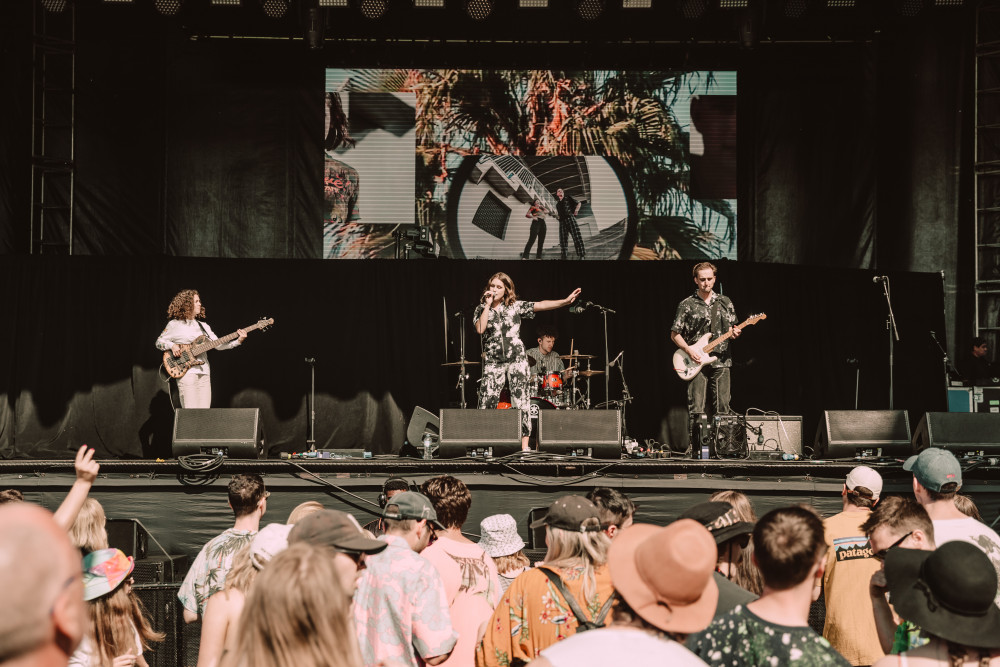
Foley performing at Spring City 2019.
Attendees were asked, given our current “unique opportunity to take risks, specifically to address the historic and ongoing overrepresentation of white male faces on lineups, what strategies or plans do you have in place to create broader or more representative lineups that better reflect Aotearoa’s audiences this year?” This question opened up the floor for hui attendees to explain how their respective festivals have made strides towards racial and gender diversity both onstage and off, but with scarce reckoning of the work that still needs to be done.
Bay Dreams director Mitch Lowe responded by firstly pointing out the female headliners that Bay Dreams has seen across the years as evidence of fair gender representation at the festival, including Cardi B and Halsey (who curiously didn’t make the cut for the ‘Bay Dreams 2020 Official Aftermovie’). Once that was noted, he suggested that it’s difficult to achieve a gender balance in festival lineups because there aren’t enough female artists appropriate for the festival to pick from. “Basically, it’s a case of what there is to book out there at the time. We’re trying to get 30,000 people out there.”
MMF NZ Chairperson and moderator of the hui Teresa Patterson pointed out the sold-out festival she and Lani Purkis launched last year. Milk & Honey was an entirely non-male festival featuring over 30 artists across six venues and four cities in Aotearoa. “So there are actually a lot of female artists out there,” she concluded with a laugh.
Laneway Festival director Julian Carswell agrees, saying in an interview with Re: that booking more non-male artists “doesn't seem too hard.” Across the last three years’ Laneway lineups, 44 percent of acts were women or included women in their group. They’re striving to improve on this with a focus on booking non-binary and transgender artists who are represented even less in lineups.
Indie artists in Aotearoa say finding and booking a diverse range of talent comes down to putting in the work.
“I’d like to see these men actually put some time and effort into doing their research,” says Yery Cho of Imugi 이무기. “Maybe it's a boys’ club thing. All over the industry, I won’t name anyone specific, but you see groups of men who love hyping each other up. Whenever they’ve got any opportunity or paid gigs, they will just work with the same group of white men.”
Ash from Foley says it’s a matter of decision-makers in the industry looking beyond those same tried-and-tested circles. “I would challenge Bay Dreams to seek out more independent acts outside of their standard channels of discovery, and ask non-male acts they have booked for recommendations or suggestions for other artists.
If they did, they might come across talent such as Lady Shaka, an interdisciplinary artist who draws from her Māori, Samoan, Tahitian, Tokelauan and Cape Verdean whakapapa in her art, and also happens to be the official DJ for IAMDDB (the sole female musician featured in the ‘Bay Dreams 2020 Official Aftermovie’).
Lady Shaka, who has recently moved to London, says, “I feel as though my work and sound is celebrated in New Zealand’s Queer scene but not so much when it comes to the New Zealand music industry and the mainstream. When I tried to reach out to festivals in New Zealand there was almost little to no response which is sad when you know you have so much to offer.”
Although New Zealand festivals were unreceptive, she did secure a slot at a festival called Glastonbury (which sadly ended up being cancelled this year due to COVID). It raises the question, what other Glastonbury-level talent are our music festivals overlooking?
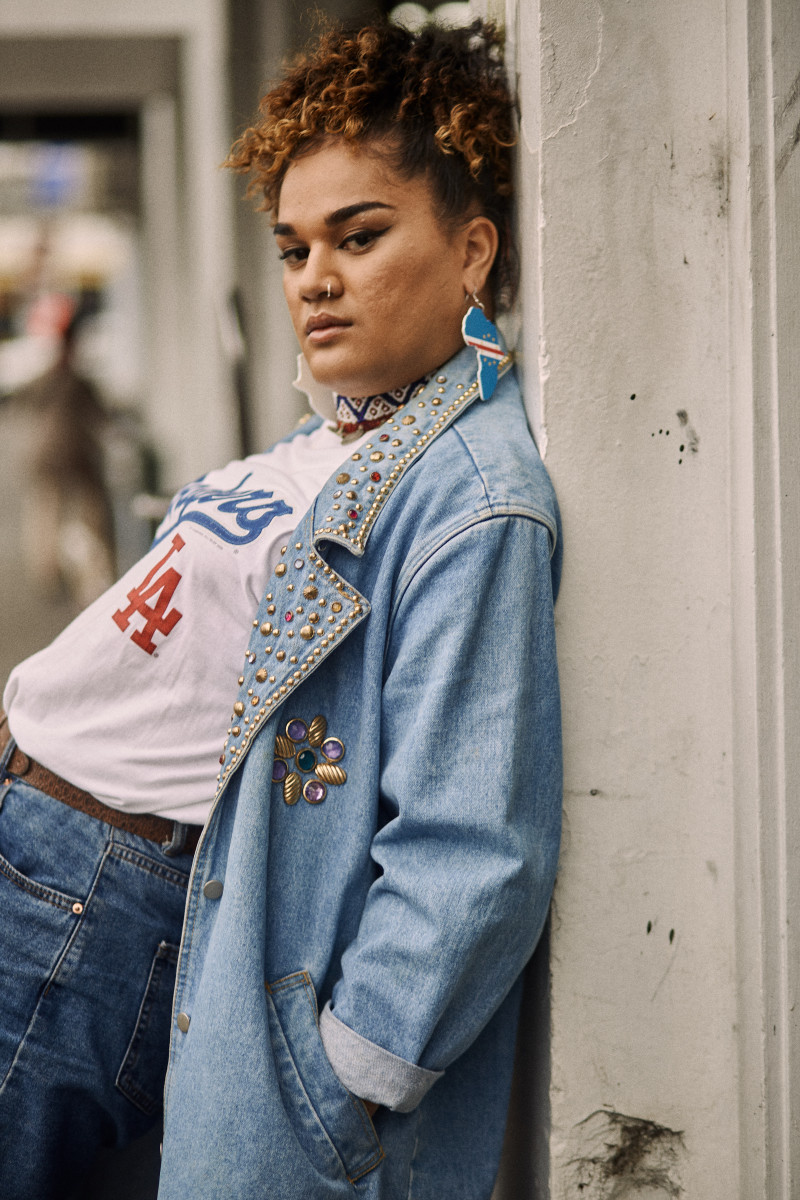
Lady Shaka. Photo: Holly Burgess
It seems, however, that making a concerted effort to find talent to represent a range of voices is something Bay Dreams director Mitch Lowe already knows how to do.
During the festival bookers and promoters hui, he explained how Bay Dreams had reached the stage in their booking process where they were “filling in those bottom slots, trying to get some diversity across the whole festival.” He elaborated that this meant “looking at the lineup and going, right, we need a surf rock band and go and dig deeper into that, or whether it’s a drum and bass DJ, or whatever it is that we’re missing when we’re looking at the poster.” Perhaps that poster is missing some more artists who aren’t cis white males.
Furthering the perception that Bay Dreams organisers are overlooking a wider range of perspectives was the recent reveal of a photo of Bay Dreams director Mitch Lowe in blackface. The photo was shared in the comments of a public Facebook post, and got a response from Lowe’s brother who suggested the photo was from a time when blackface wasn’t widely understood to be offensive. That time was 2011. Those comments have since been deleted.
Mitch Lowe shared with Re: this statement regarding the photo:
“This photo is from 9 years ago when we were young and ultimately stupid, unaware if its affect [sic]. We innocently thought we were dressing as one of our favourite artists to a themed party. We did not recognise what blackface was, and I now know that blackface isn’t a costume or something to be defended, and I certainly never intended to offend. I deeply apologise to anyone that may have found this hurtful. I am passionate about growing as a person; and I am just as passionate about helping others grow. This photo doesn’t represent the way I think or would act now. In the decade following, I have hosted hundreds of artists from every background, and I want to represent inclusivity for people from all walks of life. I have worked with, and continue to work with people from every religion, gender, culture, colour and origin. I have been very blessed to do this at a deeper level through my charity Bring People Dancing. Mental health does not discriminate. Our company would like to be part of the wider conversation and progression surrounding diversity in the industry.”
What impact do music festival lineups have?
Much of the continued lack of diversity in festival lineups is due to “people not really thinking about the impact these lineups have,” says Julian Carswell of Laneway.
Bay Dreams also received scrutiny in 2018 for booking Sticky Fingers, a band that was removed from Australian festival THIS THAT’s lineup following accusations the lead singer racially abused an Indigenous artist and verbally abused a transgender woman. Bay Dreams stood by keeping Sticky Fingers on the lineup - a decision that overlooks the signal this sends to people who have been harmed by that kind of abuse.
Why are music festival lineups important? Because they send a signal of what voices we should listen to. We can look to another cornerstone of summer music festivals, the lineup poster, for a visual representation of who’s important in the music scene right now. The top rows are reserved for the biggest money-makers and legacy acts (it is sacred ground - even the decision to make Beyoncé a headliner at Glastonbury 2011 was met with outrage from rock purists. She was the first woman to headline the festival in 20 years). They get the big font sizes. Then the font sizes typically get smaller and smaller as you go down the rows, establishing the hierarchy of artists of the moment.
What message does it send to audiences when female and gender diverse voices, especially those who are not white, barely even feature on the poster, let alone in the bottom rows?
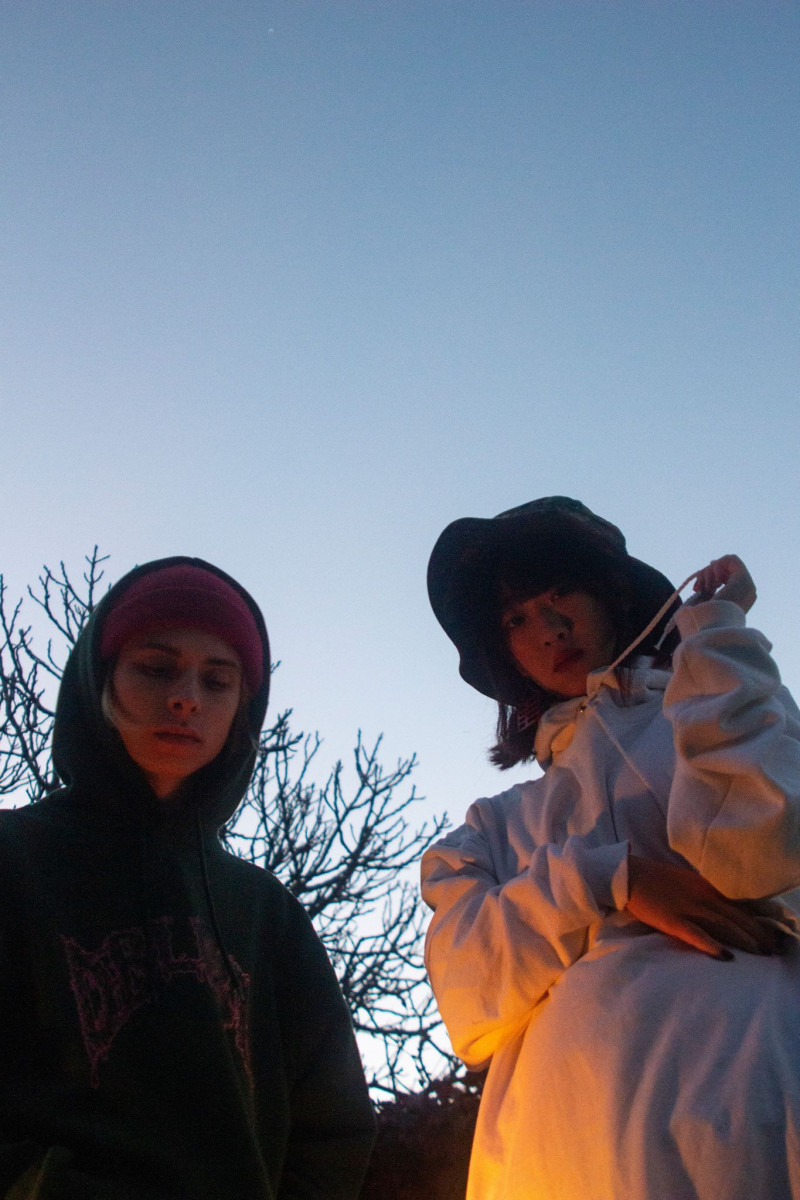
Imugi 이무기
In the festival promoters and bookers hui, Laneway promoter Mark Kneebone said they rely on the principle that, “what’s on stage should reflect what’s in the audience.” If you don’t see yourself reflected on the stage, it’s easy to think the stage is not for you.
“It really contributes to systemic oppression, straight up,” says Yery of Imugi 이무기. “It contributes to further silencing and pushing down people who are so deserving of occupying those spaces, and it makes you feel like you're not welcome and it makes you feel like you’re not deserving of being there. It makes you wonder how you can further assimilate yourself to try and get more proximity to those types of lineups.”
In an email to Re:, a Bay Dreams spokesperson explained how the diversity we see on stage can depend on supply and demand: “We have historically booked based on what the market is demanding, coupled with what is available (not committed to other shows etc). Although conscious of it, we haven't worked to a quota based on either gender or race.”
If it’s a matter of demand, Laneway and Milk & Honey are examples of the demand that exists for non-male artists. And, as Ash from Foley points out, the drawcard for major festivals is as much about the overall experience as it is the specific people on the lineup. Some festivals sell out before any lineup is released. “If you as a promoter have confidence in your festival experience, and always sell out, why not diversify your lineup?”
But a focus on supply and demand overlooks this systemic oppression that Yery talks about. When we’re working from a starting point where the stage is mostly occupied by white men, we create a cycle where only the same types of people seek a spot on that stage, and audiences are conditioned to expect and value the same types of artists.
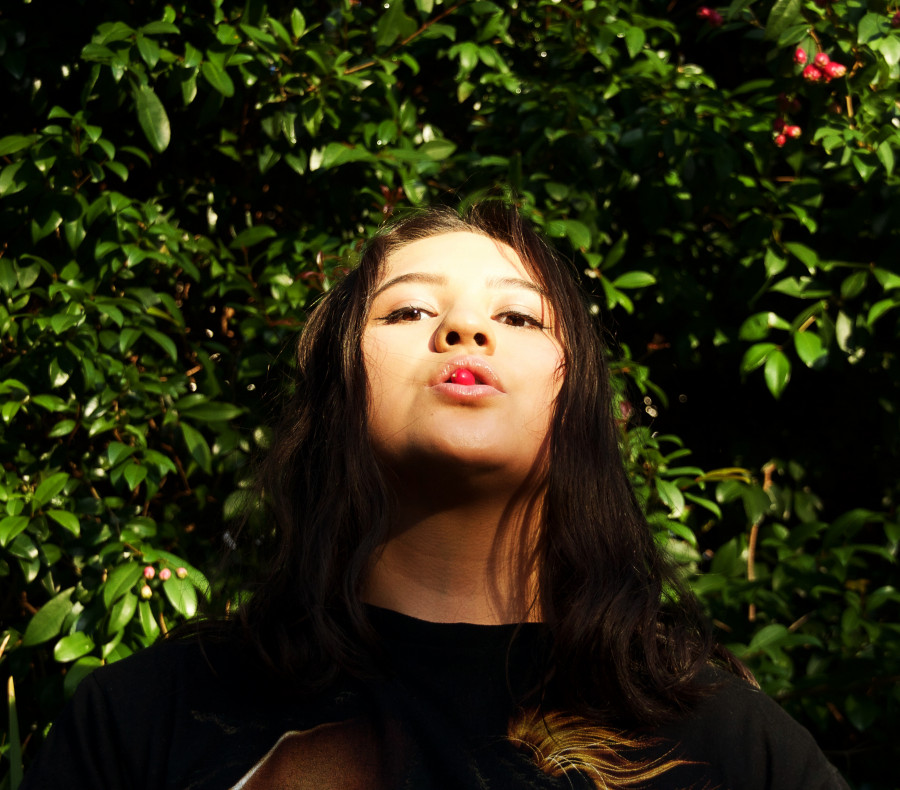
Tei. Photo: Isaac McFarlane
Auckland singer and producer Tei says, “I feel like the crowd has almost been conditioned to expect all those white DJs and they’ve been conditioned to want them and pay for them.”
Breaking that cycle requires people with decision-making power in the industry, such as festival bookers, making genuine effort to learn about music in the local community, lift up marginalised voices and pay attention to underserved audiences.
Outside of that education happening, Tei says she wants to see promoters “replaced with people who have the energy or the spirit to engage in the local scene.”
For a taste of some of the non-male music talent in Aotearoa, check out our Spotify playlist here, curated with the help of Yery from Imugi 이무기.
Banner image: Lady Shaka by Lucie Gertsch
